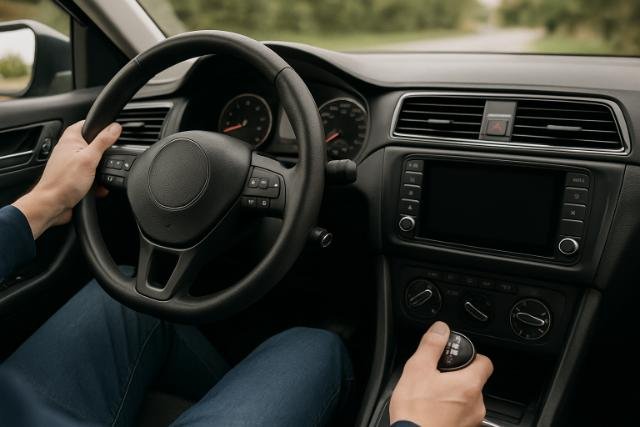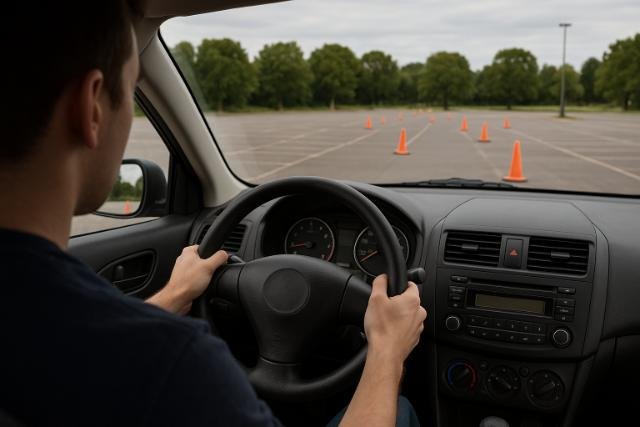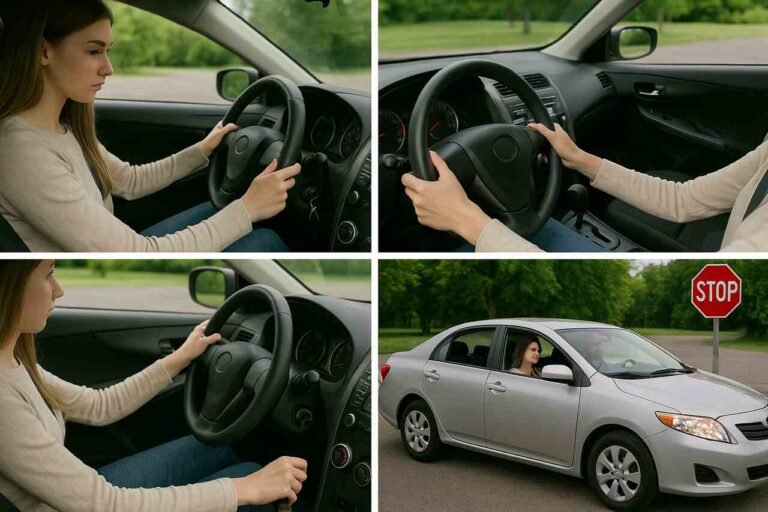Learning how to drive a car is one of the most empowering skills anyone can acquire. It offers independence, freedom, and the ability to explore new places without relying on others. Whether you are preparing for your first driving lesson or revisiting the basics to boost your confidence, understanding the entire process from getting into the driver’s seat to handling complex traffic situations is essential. This guide provides a complete, structured approach to help beginners master the skill of driving safely and confidently.
Get Familiar with the Vehicle Controls

Before turning on the engine, the first step in learning how to drive a car is to understand its main controls. Every car has essential components that must be used correctly for smooth and safe driving.
The most important controls include the steering wheel, pedals (accelerator, brake, and clutch in manual cars), gear lever, parking brake, turn signals, and dashboard indicators. Understanding the purpose and function of each control helps you operate the car with precision and confidence. The steering wheel directs the car, while the pedals control speed and braking. The gear lever adjusts power transmission, and the parking brake secures the car when stationary.
Once you are familiar with these elements, take time to observe how they respond when used. For example, notice how lightly you must press the accelerator for the car to move smoothly or how much pressure is needed on the brake pedal to stop comfortably. This awareness builds muscle memory, which is vital for real-world driving.
Adjust the Seat, Mirrors, and Steering Position
Proper seating and mirror adjustment are critical for comfort and visibility while driving. A good driving posture ensures you can reach all the controls easily and maintain a clear view of the road.
Start by adjusting the seat so that you can press the pedals fully without stretching your legs. Your knees should remain slightly bent, and your back should rest against the seat. Next, adjust the steering wheel to a comfortable height, ideally with your hands resting in the 9 and 3 o’clock positions. Ensure the wheel doesn’t block your view of the dashboard instruments.
Then, adjust your mirrors. The rearview mirror should show as much of the rear window as possible, while side mirrors should display the road beside your car without reflecting too much of your vehicle’s body. Proper mirror adjustment minimizes blind spots, which helps you make safer driving decisions.
Start the Engine and Understand Dashboard Indicators
Once you’re comfortable in the driver’s seat, the next step is to start the car and learn what the dashboard symbols mean. Each light on the dashboard serves as a communication tool between the car and the driver.
Insert the key into the ignition or press the start button in newer models. Before moving, look at the dashboard lights. Common indicators include the oil pressure light, battery charge light, engine check light, and brake warning light. All should briefly illuminate when the car starts and turn off after a few seconds. If any remain lit, it could signal a potential issue that needs attention.
Knowing what each light represents can prevent breakdowns and ensure your car remains in good working order. For example, a blinking check engine light indicates a serious problem requiring immediate inspection. Developing this awareness early helps you maintain both vehicle performance and safety.
Learn How to Use the Clutch, Brake, and Accelerator
Mastering pedal control is fundamental to learning how to drive a car, especially if you are driving a manual transmission. These three pedals, clutch, brake, and accelerator, work together to control speed and motion.
The clutch disconnects the engine from the wheels, allowing you to change gears smoothly. The brake slows or stops the car, and the accelerator increases speed. In a manual car, the sequence and timing of using these pedals must be practiced repeatedly. Start by pressing the clutch fully, shifting to first gear, then slowly releasing the clutch while gently pressing the accelerator.
Automatic cars, on the other hand, have only two pedals, brake and accelerator, making them easier for beginners. The car automatically shifts gears, allowing you to focus more on steering and traffic observation. Regardless of the transmission type, smooth coordination between your feet is key to driving confidently and safely.
Engage the Gear and Begin Moving Forward
Once the pedals are under control, it’s time to engage the gear and start moving. This is the moment where beginners often feel the first surge of excitement and nervousness.
For manual cars, press the clutch, shift into first gear, release the handbrake, and slowly ease off the clutch while pressing the accelerator. The car will start to move forward smoothly. In automatic cars, simply shift from “P” (Park) to “D” (Drive), release the brake slowly, and the car will begin to move.
As you move, keep your eyes on the road and hands firmly on the steering wheel. Avoid sudden movements, and always start in a straight line. Driving at a slow pace initially allows you to get used to the vehicle’s behavior and steering sensitivity. Over time, you’ll develop a natural rhythm that makes this process effortless.
Practice Steering and Vehicle Control

Steering control determines how well you can handle your car in various situations. Good steering technique helps maintain balance and ensures smooth lane positioning.
Always keep both hands on the wheel in the recommended 9 and 3 o’clock position. Use gentle, steady movements to change direction. Avoid crossing your arms excessively when turning, as this can reduce control. Practice driving in open spaces such as parking lots to get a feel for how much you need to turn the wheel for different maneuvers.
You can also practice driving in circles, parking, and reversing to enhance coordination. Learning steering precision early builds confidence and ensures smoother driving in real-world traffic conditions.
Learn to Use Turn Signals and Road Signs
Signaling is one of the most important communication methods between drivers. Understanding and using turn signals correctly prevents accidents and promotes predictable driving behavior.
Always use your turn signal before changing lanes, turning, or merging. This gives other road users enough time to adjust their actions. Similarly, understanding road signs such as stop signs, speed limits, and warning indicators is crucial for legal and safe driving.
Familiarize yourself with different categories of road signs: regulatory (mandatory actions), warning (potential hazards), and informational (directions and guidance). This knowledge forms the foundation of defensive driving and ensures compliance with traffic laws.
Practice Braking and Stopping Smoothly
Smooth braking is a skill that distinguishes confident drivers from beginners. The goal is to stop the car without jerking or losing balance.
Begin by practicing light braking at slow speeds. Gradually apply pressure on the brake pedal until the car comes to a stop. Avoid sudden or harsh braking unless necessary to prevent a collision. In manual cars, remember to press the clutch just before stopping to prevent stalling.
When stopping at traffic lights or in traffic, keep a safe distance from the vehicle ahead. Anticipating when to slow down instead of braking abruptly not only enhances comfort but also extends the lifespan of your brake components.
Learn to Park the Vehicle Safely
Parking is one of the most challenging parts of learning how to drive a car. However, with practice and patience, it becomes second nature.
There are three main types of parking: parallel, perpendicular, and angle parking. Each requires understanding space judgment, mirror usage, and steering precision. Start practicing in open areas or parking lots before attempting real street parking.
Use your mirrors and check surroundings before reversing. Turn the steering wheel slowly and align the car within the parking lines. Once parked, engage the handbrake and shift the gear to “P” for automatic or neutral for manual. Practicing consistently builds confidence in tight spaces.
Practice Defensive Driving Techniques

Defensive driving involves anticipating potential hazards and making proactive decisions to avoid accidents. It’s about staying alert, patient, and cautious at all times.
Maintain a safe following distance, typically a three-second gap from the vehicle ahead, to allow enough time to react. Always check your mirrors frequently, especially before changing lanes or turning. Avoid distractions such as using a phone or adjusting controls while driving.
Defensive drivers also remain calm under pressure. They predict other drivers’ behaviors, recognize risky situations early, and respond appropriately. This mindset not only improves safety but also reduces stress and fatigue during long drives.
Follow Traffic Rules and Local Driving Laws
Every region has specific traffic laws designed to maintain road safety and order. Knowing and obeying these rules is a fundamental part of learning how to drive a car.
Familiarize yourself with local speed limits, lane regulations, and right-of-way principles. For example, always yield to pedestrians at crosswalks and stop completely at stop signs. Ignoring such rules can lead to fines, penalties, or accidents.
Many drivers overlook the importance of road courtesy, but small gestures like letting others merge or using turn signals on time enhance road harmony. Respecting laws and other drivers ensures safer, more efficient traffic flow.
Handle Special Driving Situations
Driving conditions vary depending on weather, road surface, and traffic volume. Being prepared for different situations ensures adaptability and safety.
For wet or icy roads, reduce speed and increase braking distance since tires have less grip. In heavy traffic, maintain steady speed and avoid frequent lane changes. When driving at night, use headlights responsibly and switch to low beams when another vehicle approaches.
Driving on highways requires higher speed awareness and lane discipline. Always use the rightmost lane for slower speeds and overtake only when necessary. Adapting your technique based on conditions helps you become a versatile and safe driver.
Comparison of Manual vs Automatic Transmission for Beginners
| Feature | Manual Transmission | Automatic Transmission |
| Pedals | Three (Clutch, Brake, Accelerator) | Two (Brake, Accelerator) |
| Gear Shifting | Manual via gear lever | Automatic shifting |
| Control Level | Higher, full driver control | Easier for beginners |
| Learning Curve | Steeper, requires coordination | Simpler, faster to learn |
| Fuel Efficiency | Often better | Slightly less efficient |
Essential Checks Before Starting Your Drive
| Step | Item to Check | Purpose |
| 1 | Mirrors | Clear visibility |
| 2 | Seat Position | Comfort and reach |
| 3 | Handbrake | Safety before start |
| 4 | Dashboard Lights | Detect any issues |
| 5 | Fuel Level | Ensure sufficient range |
Build Confidence Through Regular Practice
Consistency is the key to becoming a skilled driver. Every driving session helps reinforce coordination, awareness, and reaction time.
Start practicing in low-traffic areas or driving schools. Gradually progress to busier roads as your confidence grows. Repetition helps you develop instinctive control, reducing hesitation in real driving conditions.
Over time, you’ll notice improvements in your ability to judge distances, anticipate other drivers’ actions, and handle diverse environments. Confidence doesn’t come overnight; it’s built through continuous, mindful practice.
Prepare for Your Driving Test
If your goal is to earn a driver’s license, preparing for the driving test is the final step. The test typically evaluates both theoretical knowledge and practical driving skills.
Review your local traffic rules, road signs, and driving scenarios. During the test, focus on maintaining calmness, following instructions precisely, and demonstrating awareness. Practice maneuvers such as parking, three-point turns, and lane changes before the exam.
Passing the test requires not only technical ability but also a composed mindset. Staying calm helps you make better decisions and present your driving skills with confidence.
Conclusion
Learning how to drive a car is a process that combines technical skill, observation, and emotional control. From understanding the basic controls to mastering defensive driving, every step builds your confidence behind the wheel. With consistent practice and adherence to safety rules, anyone can become a capable and responsible driver. Remember, driving is not just about reaching a destination; it’s about doing so safely, smoothly, and responsibly.
FAQ’s
It depends on your practice frequency and confidence level. Most beginners take 20 to 40 hours of driving practice to become comfortable with basic skills.
If you want an easier start, choose an automatic car. If you want full control and flexibility for all car types, start with manual training.
Common mistakes include oversteering, harsh braking, ignoring mirrors, and forgetting to signal. Regular practice helps eliminate these habits.
Start practicing in quiet areas, drive with an instructor or calm friend, and gradually expose yourself to busier roads to build confidence.
While self-practice helps, professional driving schools provide structured learning, safety techniques, and insights that improve overall skill.
Slow down, maintain extra distance, use proper headlights, and avoid sudden steering or braking movements.

